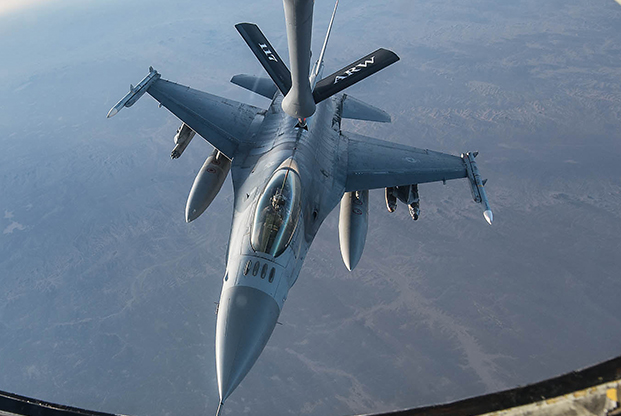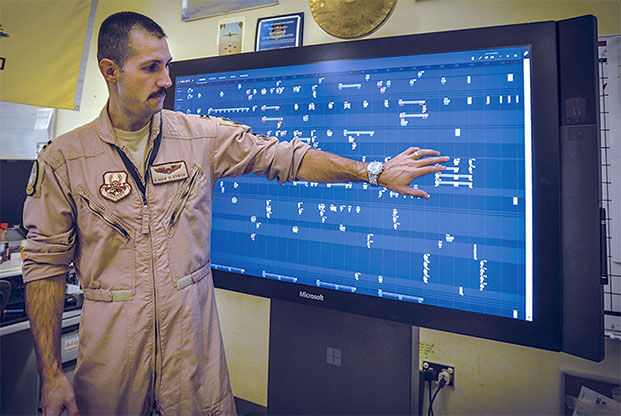
An F-16 Falcon is refueled by a KC-135 Stratotanker. A new program called Jigsaw allowed CAOC planners to ditch the whiteboards previously used for tanker planning. Photo: MSgt. Phil Speck/ANG
Maj. Eric Bow used to spend most of his workday copying and pasting. As the targeting effects team chief, Bow created a lot of PowerPoint slides and Excel documents, and a lot of information was conveyed by phone or email.
Now, thanks to a target development management program called Raven, all of the “junk” and duplication of effort has gone away, cutting 12 hours of work down to three or four hours.
“We were killing ourselves back in Raqqa and Mosul,” Bow said recently, as he walked Air Force Magazine through the process of developing a target.
Raven is one of about six Defense Innovation Unit-Experimental (DIUx) programs running now at the Combined Air Operations Center (CAOC) at Al Udeid AB, Qatar. Most were developed and reached initial operational capability within the last year, and helped increase efficiencies and effectiveness, reduced man hours, and increased savings, explained Col. Mike Drowley, US Air Forces Central Command chief of staff.
In the CENTCOM area, Drowley said there are multiple streams of information from multiple places: signals intelligence, communications intelligence, and human intelligence. When Lt. Gen. Jeffrey L. Harrigian became the commander of AFCENT, one of his imperatives was, “how do we manage all this data and then how do we effectively give it to the people that need to utilize it the most,” Drowley said.

Capt. Gary Olkowski, seen here with Jigsaw, the Pentagon’s digital tanker planning tool. Photo: USAF
One of the first programs to roll out in March 2017 was a tanker planning tool called Jigsaw. Previously, Drowley said, it took five or six people upward of eight hours each day to plan tanker flights, using magnets on a giant whiteboard. Now it’s down to one or two people for two or three hours a day, and the whiteboard has been replaced with a dual touch screen that has generated savings of 400,000 to 500,000 pounds of fuel—or $750,000 to $1 million—each week.
“It was literally a whiteboard with a dry-erase marker, trying to figure out what receivers are going to one tanker, and then all of a sudden, a change would come in at the two-hour point, and you’d have to completely wipe the board and start all over again,” Drowley said.
Now, the tanker planning airmen can just click on an icon and drop it on another location, and the program calculates everything—from how much fuel the tanker has left to the available airspace—Maj. Derrick Baker, air refueling coordination chief, explained.
The program eliminates the need for tedious math, reduces the potential for human error, and allows them to redo the plan in a matter of minutes, versus hours, said Baker.
_
Read this story in our print issue:
At the same time, on the combat operations division floor, Marine Corps dynamic targeting chief Capt. David Wesalo is using a program called Chainsaw for dynamic targeting and communicating with coders in real time to provide feedback.
The program consolidates “a ton of programs into one,” reducing a process that took an hour or two, to a matter of minutes, he said.
Chainsaw reached initial operational capability in mid-November, just 120 days from its inception, and Wesalo said he’s already given the developers about 50 suggestions. He likened the initial program to a skateboard, with the goal of using user feedback to evolve that skateboard into a Ferrari.
Drowley said the speed the programs are developed is unlike anything he’s ever seen in the military, and much of it is due to an iterative, adaptive approach that doesn’t focus on getting a perfect solution right out of the gate. Airmen work with DIUx coders to identify what they need, and the first version of a program is usually about a “60 percent solution,” Drowley said.
Then, users begin to use the beta version and give constant feedback about how to change or improve the program, which has allowed rapid changes to meet real needs.
“We’re not looking for the home runs here, we’re trying to get a bunch of singles and make progress,” he explained. “You’re trying to come up with that first step, and once you have that first step, now you do rapid iterations to get to where we need to be.”
The command also sends airmen to Silicon Valley to learn about the culture and the processes, and brings coders to the CAOC to see what operations are going on and what the requirements are.
Drowley said, It’s all part of a culture that we are trying to build where “we don’t want airmen thinking like airmen, we want them thinking innovatively, we want them thinking differently.”
“We don’t want just one way of thought,” he added.
_
Jennifer Hlad is a freelance journalist based in the Middle East and a former Air Force Magazine senior editor.
